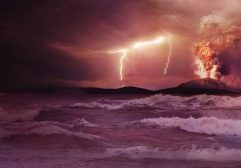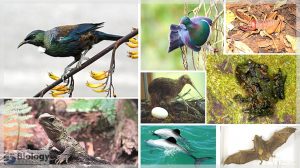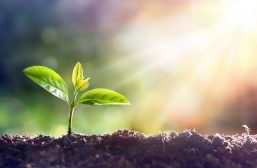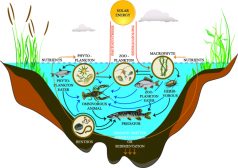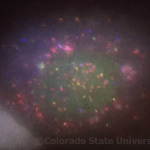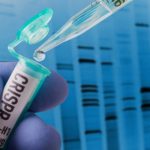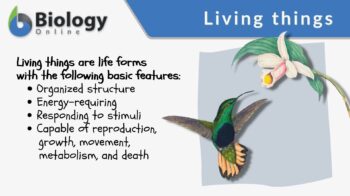
Living things
n., singular: living thing
[ˈlɪvɪŋ θɪŋ]
Definition: any organism or a life form that possesses or shows the characteristics of life or being alive
Table of Contents
Living Things Definition
A living thing pertains to any organism or a life form that possesses or shows the characteristics of life or being alive. The fundamental characteristics are as follows: having an organized structure, requiring energy, responding to stimuli and adapting to environmental changes, and being capable of reproduction, growth, movement, metabolism, and death. Currently, living things are classified into three Domains: (Eu)Bacteria (true bacteria), Archaea (archaebacteria), and Eucarya (eukaryotes).
Etymology: The term living came from the Old English lifende, meaning “living” or “having life”. The term thing came from the Old English þing, meaning “entity”, “being”, “body”, or “matter”. Synonyms: organism; life form; creature.
History
While Earth is presumed to be about 4.54 billion years old, life on Earth began later, probably around 3.5 billion years ago, although others believe that life may have started earlier than that.
Abiogenesis
The origin of life, also referred to as abiogenesis, refers to the natural process in which life came about from non-living matter or lifeless objects. How this occurred remains a matter of debate among scientists. Till now, there is no consensus as to how life on Earth began.
Primordial soup
The “primordial soup” refers to the hypothetical model of the primitive Earth wherein it accumulated organic material and water resembling a soup. This soup served as a site where organic compounds were synthesized. A widely-accepted research finding is that of the Miller–Urey experiment. Apparently, the simulated-primitive Earth favored the chemical syntheses of the basic structure of the cell membrane (e.g. phospholipids forming lipid bilayers) and organic compounds from inorganic sources. The primordial soup is also the edict of the heterotrophic theory of the origin of life proposed by Alexander Oparin and John Burdon Sanderson Haldane.
RNA world hypothesis
The transition from non-living to living entities may have occurred gradually. One of the popular theories held today is the RNA world hypothesis, which suggests that primordial life was based on RNA because it can act as both genetic material and catalyst. This RNA-based life could have served as the descendants of the current life on Earth.
The building blocks of RNA and DNA may have originated and formed in the asteroids from outer space and then reached the Earth through meteorites. According to NASA, they found RNA and DNA nucleobases such as adenine and guanine in meteorites. (1) These nucleobases could have led to the spontaneous creation of RNA and DNA.
These organic molecules might have been used by the first life forms to live and propagate. The earliest life forms might be the single-celled organisms that came into existence near the end of Hadean Eon or early in the Archean Eon. This is based on the discovery of graphite of biogenic origin in Western Greenland which was estimated to be 3.7 billion years old. (2) Organisms lacking membrane-bound organelles were likely the first living entities to have dominated the Earth. They are referred to as prokaryotes, a group comprised of bacteria and archaea.
Forum Question: Is DNA living or non-living thing? Featured Answer!
Endosymbiotic theory
The endosymbiotic theory posits that endosymbiosis between a larger cell and a prokaryote led to the first photosynthetic eukaryote. Based on this theory, the larger eukaryote might have engulfed prokaryotes that over time transformed into semi-autonomous organelles, such as chloroplasts and mitochondria inside the cell.
Multicellularity
Multicellular life probably began 600 million years ago and occurred several times in biological history. The most popular theory on the origin of multicellularity is Haeckel’s Gastraea Theory. Accordingly, multicellularity first occurred when cells of the same species group together in a blastula-like colony. Gradually, certain cells in the colony underwent cell differentiation. However, this theory is still inadequate in explaining the origin of multicellularity.
Ediacaran biota comprised of single-celled and multicellular organisms existed in the Ediacaran period, around 600 million years ago. In this biota, the earliest animals first appeared. They resemble sponges with sizes ranging from 1 cm to less than 1m. (3)
Cambrian explosion
Around 541 million years ago, a sudden burst of life occurred in the Cambrian period. This is referred to as the Cambrian explosion. Diverse plants and animals came into being. In the late Cambrian or Early Ordovician period, animals began to venture into the land. With the evolution of land plants, the animals, too, evolved and diversified. Eventually, they colonized terrestrial habitats, including farther inland.
Current population
In May 2016, the estimated total number of species on Earth is about 1 trillion. (4) In 2011, the Census of Marine Life estimated about 8.7 million eukaryote species on Earth. (5) Unfortunately, many of the living things (probably over five billion species) that ever lived on Earth became extinct.
Watch this vid about the origin of life on Earth:
Classification
Living things were initially classified as either a plant or an animal. While both animals and plants are eukaryotic, they are distinguished based on their defining characteristics, e.g. in terms of motility, mode of nutrition, and cellular features. Animals, basically, are living things that are motile and heterotrophic whereas plants are those that are non-motile, photosynthetic, autotrophic (i.e., capable of producing their own food), and have a cell wall. However, bacteria and archaea are neither plants nor animals mainly because they are prokaryotes (i.e. lacking in membrane-bound cytoplasmic organelles, including the nucleus).
As for the distinction between bacteria and archaea, one of their differences lies in RNA polymerase. In archaea, it has ten subunits. In bacteria, it has four. Another example is the composition of the cell wall. The archaeal cell wall lacks peptidoglycan whereas the bacterial cell wall has.
At present, the modern biological taxonomy entails the classification of living things into three domains: (1) domain Eukarya, (2) domain Bacteria, and (3) domain Archaea. A biological domain is the highest taxonomic rank of organisms according to Carl Woese’s 3-domain system of taxonomy. Below the domain are seven major taxonomic ranks. In descending order, they are as follows:
Domain » Kingdom » Phylum » Class » Order » Family » Genus » Species
Domain Eukarya includes all living things that are eukaryotic. These include animals, plants, fungi, algae, and protists. They possess membrane-bound organelles within their cells.
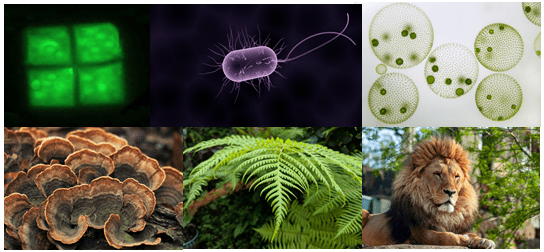
Characteristics of Living Things
Living things are organisms that show the characteristics of being alive. What separates living things from non-living things is the following characteristics:
-
An organized structure
Living things are organized structures. It may be a single-celled such as a bacterial cell, or multicellular such as animals and plants that are made up of several cells. A cell is the fundamental biological unit of an organism. Various cellular processes are carried out by the cell in an orchestrated, systematized manner. A cell consists of protoplasm surrounded by a plasma membrane. Cytoplasmic structures (e.g. organelles), each with specific roles and functions, are suspended in the cell’s cytosol.
In multicellular organisms, their body is made up of cells, which are organized into tissues. The tissues, in turn, are organized into biological organs and systems. These structures, although with distinct functions, work together in a coordinated fashion. Thus, an organism, whether it is made up of one or more cells, is an assembly from a systematic, coherent design.
-
Energy-requiring
Living things require energy for survival. Energy is essential as it fuels numerous metabolic activities of a cell. One way that living organisms synthesize energy is by photosynthesis where light energy is converted into chemical energy. Another is by cellular respiration wherein biochemical energy is harvested from an organic substance (e.g. glucose) and, then, stored in an energy-carrying biomolecule such as ATP for later use.
-
Reproductive capacity
A living thing is capable of reproducing. There are two ways by which living things can reproduce copies of themselves: sexual reproduction and asexual reproduction. In sexual reproduction, male and female sex cells of the two parents unite and form a zygote that will develop eventually into a being of their own kind. Asexual reproduction, in contrast, is a mode of reproduction that does not involve the fertilization of gametes or sex cells. The offspring comes from only one parent. Examples include binary fission, budding, vegetative propagation, sporogenesis, fragmentation, parthenogenesis, apomixis, and nucellar embryony.
-
Growth
Living things grow. At the cellular level, growth may refer to an increase in number or to an increase in size. The increase in the number of cells is through cell division. The stem cells of animals and the meristematic cells of plants divide to give rise to new living cells. As for the increase in cell size, it is attributed often to the increase in cytoplasmic mass.
The cell undergoes a series of phases in the cell cycle. Most of the time, the new cell produced by mitosis undergoes interphase. It is the phase in the cell cycle wherein the cell grows in size. Unless fully differentiated, the cell could replicate its DNA to prepare for the next cell division. In plants, new cells increase in volume by taking in and storing water inside a vacuole.
Some of the plant cells grow a secondary cell wall between the primary cell wall and the plasma membrane. At the tissue level, growth in vascular plants is of two types: primary and secondary. Primary growth entails vertical growth as primary xylem forms from the procambium whereas secondary growth is associated with lateral growth caused by the formation of secondary xylem from the vascular cambium.
In higher forms of animals, the growth of tissues follows a pattern and is genetically predetermined. Regeneration capacities are not as indefinite as those in plants. The extent of regeneration varies among species. For instance, salamanders can regenerate new eyes or new limbs whereas humans cannot. Nevertheless, humans are also capable of regenerating certain parts of their body, such as skin and parts of the liver.
Forum Question: What are the advantages and disadvantages of being a large organism? Featured Answer!
-
Metabolism
A living thing metabolizes. Metabolism refers to the various life processes that are responsible for the keeping up of the living state of a cell or an organism. Examples of those involved in cell growth, respiration, reproduction, response to stimuli, sustenance, biomolecular syntheses, waste elimination, and other homeostatic processes.
There are two forms of metabolism: catabolism and anabolism. In catabolism, living things carry out degradative chemical reactions that lead to the breaking down of complex molecules into smaller units and obtain energy that is released from the process. In anabolism, energy-driven chemical reactions build molecules from smaller units.
-
Homeostasis
Living things tend to adjust to achieve a stable internal environment. They possess dynamic mechanisms (positive and negative feedback loops) that control and orchestrate biological systems in order to stay within the range of favorable or ideal internal conditions. Thermoregulation, osmoregulation, calcium homeostasis, and potassium homeostasis are just a few of the multifarious homeostatic processes vital to life. Achieving balance is crucial to the proper functioning and survival of an individual.
-
Responsive to stimuli
Living things respond to stimuli and adapt to environmental changes. A living organism can detect changes in the environment, especially by cells that function as receptors. For instance, humans have five fundamental senses: sight, hearing, smell, touch, and taste. Other senses are the vestibular sense (detects body movement, direction, and acceleration), sense for thermoception, kinesthetic sense (detects body part positions), internal sense (interoception), and so on. Apart from detecting changes in its surroundings, it can also adapt to these changes.
-
Adaptation and Evolution
Living things adapt and have the capacity to evolve. The ability of organisms to respond accordingly to changes in their environment enables them to adapt over time. This means the species has eventually acquired the trait that is functional, beneficial, and heritable. This, in turn, could lead to the gradual change and diversification of organisms across generations where species possess distinctive features driven by natural selection — an indication of evolution.
-
Movement
A living thing moves. Since a living thing can detect stimuli from its surroundings, it can respond accordingly. For example, animals move to forage, escape predators, and seek a potential mate. While animals can move at will, plants have a rather limited form of movement, referred to as nastic movement (e.g. thigmonasty, nyctinasty).
-
Death
Living things die. A living thing has life and this life ends eventually. At a certain point in the typical life cycle of organisms, there will come a time wherein an individual starts to experience a gradual decline in physical robustness, function, and capacity. This marks the period of senescence.
Senescence refers to biological aging. It is when living things gradually deteriorate over the course of their life. The organism gradually loses its ability to function and deal with stressors. As such, it becomes more vulnerable to diseases and dysfunction. At the cellular level, the cell no longer divides although it may still be metabolically active. One of the natural causes of cellular senescence is the shortening of telomeres leading to DNA damage. Conversely, some living beings are regarded as immortal because they seem to circumvent death. Examples include the age-reversing jellyfish Turritopsis doohmii, the regenerating flatworms, and the seemingly indestructible tardigrades. Thus, different species could have variations in their life stages. While some organisms have shorter life stages, others have longer lifespans owing to the complexity of their growth and development.
Non-cellular life
Are viruses living things? This question has sparked major debate among biologists for so long. Some would consider viruses as living things since they appear to be alive when they are inside their host. They possess genetic material, replicate themselves, and evolve by natural selection. However, others do not take them as living things because they are essentially dead when outside their host. Viruses cannot reproduce independently.
They rely on the host cell’s machinery to do so. Thus, viruses are not absolutely living or non-living. When outside their host, viruses are inactive and seemingly inanimate. When inside their host, they became active, capable of utilizing the host cell‘s structures and replicating. Viroids are another group that seems to be a non-cellular life. They are infectious and pathogenic short strands of circular, single-stranded RNA.
Research
The study of living things is called biology (also called biological science). An expert in this field is called a biologist. Several areas of biological studies include morphology, anatomy, cytology, histology, physiology, ecology, evolution, taxonomy, and pathology.
NOTE IT!
“Living things that mimic non-living things”
One of the distinctive features of a living thing is its ability to adapt. Some organisms, though, have leveled up a notch by possessing the ability to “mimic” their surroundings. Because of such an astounding deceptive strategy to “hide”, these organisms can trick others into believing they are non-living things when, in fact, they are alive. Here are some of them!
- Lithops sp. also known as “living stones” may look like rocks but they’re actually a group of succulent plants.
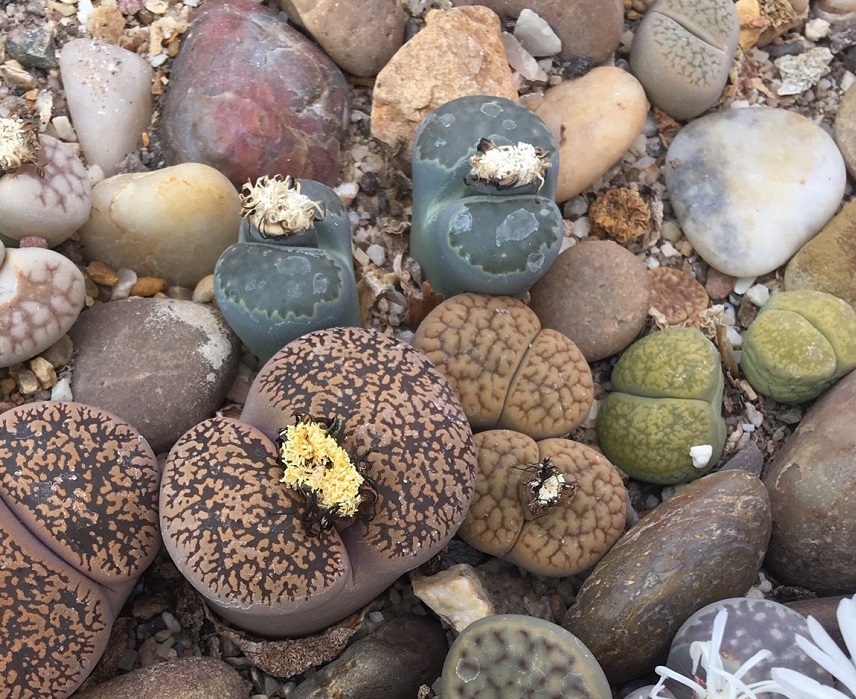
- Watch out! This venomous stonefish can look like a stone or rock.
- Flounders matching the sandy or rocky substrate on the ocean floor
Try to answer the quiz below to check what you have learned so far about living things.
See also
- Life
- Organism
- Biome
- Homeostasis
- Mitosis
- Apoptosis
- Non-living thing
References
- NASA – NASA Researchers: DNA Building Blocks Can Be Made in Space. (2011, January 1). Retrieved from Link
- Ohtomo, Y., Kakegawa, T., Ishida, A., Nagase, T., & Rosing, M. T. (2013). Evidence for biogenic graphite in early Archaean Isua metasedimentary rocks. Nature Geoscience, 7(1), 25–28. Link
- The History of Animal Evolution. (2000, January 1). Retrieved from Link
- Researchers find that Earth may be home to 1 trillion species NSF – National Science Foundation. (2016, January 1). Retrieved from https://www.nsf.gov/news/news_summ.jsp?cntn_id=138446
- Census of Marine Life. (2011, August 24). How many species on Earth? About 8.7 million, new estimate says. ScienceDaily. Retrieved from Link
Further reading
- Characteristics of living things – Science Learning Hub. (Additional resource material that depicts the characteristics of living things).
© Biology Online. Content provided and moderated by Biology Online Editors

